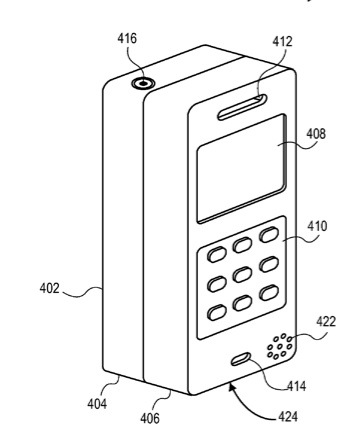Apple is working on ways to improve its speakers, especially on its small, mobile devices such as the iPhone. An Apple patent (number 20120128190) for a gas filled speaker volume has appeared at the U.S. Patent & Trademark Office.
Per the patent, a speaker enclosure includes a gas cavity and an air cavity separated by a flexible membrane. A diaphragm is located roughly in an opening of the enclosure surrounding the gas cavity and attached to the enclosure by an outer suspension member. The enclosure, the flexible membrane, the diaphragm, and the outer suspension member are gas and air impermeable. The enclosure surrounding the air cavity has a vent hole to allow air to travel into and out of the air cavity for barometric pressure equalization of the gas cavity.
Here’s Apple’s background and summary of the invention: “n most speaker systems, a vibrating diaphragm is mounted at an opening of a speaker enclosure. A common type of speaker enclosure is a sealed enclosure. In a sealed speaker enclosure, the diaphragm compresses air in the enclosure when it moves in and rarefies air when it moves out. In smaller speaker and enclosure designs, substantial back pressures are exerted against the vibrating diaphragm by the air within the enclosure.
“This back pressure retards the movement of the diaphragm and degrades the quality of the sound being reproduced. To effectively enlarge the volume of the speaker enclosure, the air within the enclosure can be replaced with a gas that is less dense than air.
“However, with mobile devices, the barometric air pressure surrounding the speaker enclosure can decrease or increase abruptly, for example when the user is riding in an elevator. This will result in a net force being exerted on the diaphragm of the sealed speaker system, causing it to “stick” and therefore stop producing sound until the pressure inside the speaker has equalized with the barometer pressure (due to leakage).
“In air speaker systems, such barometric equalization is achieved relatively quickly (in order to prevent noticeable sticking of the diaphragm), by adding a small vent hole to the enclosure (at the expense of a small amount of sound quality degradation). This solution however will not work for an enclosure that is filled with gas and no air.
“A speaker system for enlarging the effective volume of a speaker enclosure is described. The speaker system includes a speaker enclosure having an interior partition to separate a gas cavity and an air cavity. A diaphragm is located at an opening of the enclosure surrounding the gas cavity. The gas cavity is filled with a gas that is less dense than air (e.g., helium or hydrogen) to effectively enlarge the volume of the gas cavity.
“The interior partition separating the gas cavity and the air cavity has an opening that is sealed by a flexible membrane. The enclosure surrounding the air cavity has a vent hole to allow the surrounding air to travel into and out of the air cavity.
“As the air pressure surrounding the speaker enclosure decreases, the gas inside the enclosure will be allowed to expand. The flexible membrane between the gas cavity and the air cavity may allow the gas to expand without significantly increasing the net force on the diaphragm as the vent hole will allow air to travel out of the air cavity. Similarly, when the air pressure surrounding the speaker enclosure increases, the gas within the enclosure will be allowed to contract.
“The vent hole will allow the air to travel into the air cavity, and the flexible membrane will allow the gas to contract without creating a vacuum on the diaphragm. Therefore, there is very little pressure change on the diaphragm when the barometric pressure changes.”
Ching Yu John Tam is the inventor.
Along the same line is patent number 20120128189, which involves an integrated speaker assembly for a personal media device. Systems and methods are provided for media devices including a housing, a frame disposed adjacent to the housing, and an acoustic source that is integrated with the frame for emitting sound from the media device.
Here’s Apple’s summary of the invention: “The invention, in various embodiments, addresses deficiencies in the prior art by providing systems, methods and devices that enhance the ability of the acoustic source to withstand physical stresses and enhance sound quality while respecting the need for a compact and portable form factor for such devices.
“In various aspects, the invention employs an acoustic source, e.g., a speaker assembly, in a media device. The acoustic source is integrated with at least a portion of the frame of the media device. Because a frame provides structural support for the media device, the frame generally has greater structural strength than, for example, a housing or internal circuit board of the media device.
“By integrating the acoustic source with a frame having greater structural strength and integrity, the ability of the acoustic source to withstand physical stresses or vibrations is enhanced. The term ‘integrated with’ may include integrally formed with, unitarily formed with, attached to, detachably connected to, mounted on, or any like permanent, semi-permanent, or temporary configuration whereby the acoustic assembly, or a portion thereof, is in physical communication or contact with the frame of the media device.
“In one aspect, a media device includes a housing, a frame disposed adjacent to the housing, and an acoustic source that is integrated with the frame for emitting sound from the media device. The frame may be disposed substantially within the housing. The frame may include a sidewall or plurality of sidewalls. At least one sidewall may include an aperture in acoustic communication with the acoustic source.
“The frame may include a backplane. A portion of the acoustic source may be positioned substantially on a top surface of the backplane. A portion of the acoustic source may be enclosed within an upper casing where the upper casing is attached to the frame. Also, a portion of the acoustic source may be positioned substantially on a bottom surface of the backplane. A portion of the acoustic source may be enclosed within a lower casing where the lower casing is attached to the frame. The frame may be connected to the housing using at least one gasket.
“Another aspect of the invention includes a method for manufacturing a media device. The method includes providing a housing, attaching a frame to the housing, and integrating an acoustic source with the frame. The integration may include inserting an acoustic source within a recess of the frame. In one feature, an upper casing is mounted to the frame proximate to the acoustic. In another feature, a lower casing is mounted to the frame proximate to the acoustic source.”
The inventors are Richard Hung Minh Dinh, Tang Yew Tan and Derek Boyd Barrentine.



